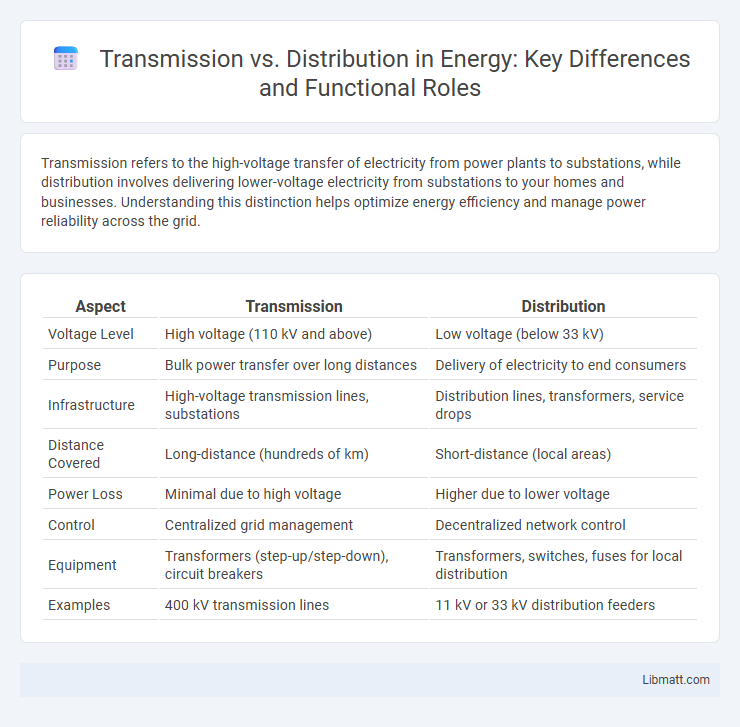Transmission refers to the high-voltage transfer of electricity from power plants to substations, while distribution involves delivering lower-voltage electricity from substations to your homes and businesses. Understanding this distinction helps optimize energy efficiency and manage power reliability across the grid.
Table of Comparison
| Aspect | Transmission | Distribution |
|---|---|---|
| Voltage Level | High voltage (110 kV and above) | Low voltage (below 33 kV) |
| Purpose | Bulk power transfer over long distances | Delivery of electricity to end consumers |
| Infrastructure | High-voltage transmission lines, substations | Distribution lines, transformers, service drops |
| Distance Covered | Long-distance (hundreds of km) | Short-distance (local areas) |
| Power Loss | Minimal due to high voltage | Higher due to lower voltage |
| Control | Centralized grid management | Decentralized network control |
| Equipment | Transformers (step-up/step-down), circuit breakers | Transformers, switches, fuses for local distribution |
| Examples | 400 kV transmission lines | 11 kV or 33 kV distribution feeders |
Understanding Power Transmission and Distribution
Power transmission involves the high-voltage transfer of electricity from generation plants to substations over long distances, minimizing energy loss through efficient conductors and transformers. Distribution manages the lower-voltage delivery of electricity from substations to end users, ensuring safe and reliable access to residential, commercial, and industrial consumers. Both systems integrate protective devices and smart grid technologies to optimize performance and maintain grid stability.
Key Differences Between Transmission and Distribution
Transmission systems operate at high voltages ranging from 69 kV to 765 kV to efficiently transport bulk electrical power over long distances from generation plants to substations. In contrast, distribution networks step down voltage levels to 4 kV to 35 kV to deliver electricity safely to residential, commercial, and industrial consumers. Key differences include the voltage levels, distance covered, infrastructure such as transmission towers versus distribution poles, and the role each plays in the electrical power delivery chain.
The Role of Voltage Levels in Transmission and Distribution
Voltage levels play a critical role in differentiating transmission and distribution systems, with transmission operating at high voltages typically above 110 kV to efficiently transport electricity over long distances with minimal losses. Distribution networks reduce voltage to medium and low levels, usually below 33 kV, to safely deliver electric power to homes and businesses. Proper voltage regulation in distribution enhances equipment performance and ensures consumer safety, while high-voltage transmission enables large-scale power transfer across regional grids.
Infrastructure Components in Transmission vs Distribution
Transmission infrastructure includes high-voltage power lines, substations, transformers, and switching stations designed to transport electricity over long distances efficiently. Distribution infrastructure consists of lower-voltage distribution lines, pole-mounted transformers, service drops, and distribution substations that deliver electricity directly to homes and businesses. Understanding the differences in your local grid's infrastructure components helps optimize maintenance and improve energy delivery reliability.
Transmission Systems: High Voltage, Long Distance
Transmission systems operate at high voltage levels, typically ranging from 110 kV to 765 kV, enabling efficient long-distance power transfer with minimal losses across vast geographic areas. These systems utilize large-scale infrastructure such as steel lattice towers and insulated conductors to transport bulk electricity from generation plants to regional substations. By maintaining elevated voltages, transmission lines reduce current flow, thereby minimizing resistive losses and ensuring reliability in delivering electricity over hundreds of kilometers.
Distribution Systems: Lower Voltage, Local Delivery
Distribution systems operate at lower voltage levels, typically ranging from 4 kV to 35 kV, to safely deliver electricity directly to residential, commercial, and industrial end-users. These systems branch out locally from substations, ensuring efficient voltage reduction and reliable power delivery within neighborhoods and business districts. The infrastructure includes transformers, distribution lines, and service drops designed to handle localized energy loads and maintain stable voltage quality.
Energy Losses: Transmission vs Distribution
Energy losses in transmission primarily occur due to the resistance of high-voltage power lines, typically ranging from 2% to 6% depending on distance and voltage levels. Distribution losses tend to be higher, often between 5% and 10%, because of lower voltage levels, increased current flow, and numerous transformers and connections. Advanced technologies like high-voltage direct current (HVDC) transmission and smart grid management are being deployed to minimize these losses and improve overall efficiency.
Grid Reliability in Transmission and Distribution
Grid reliability in transmission involves maintaining high-voltage lines that transport electricity over long distances, ensuring minimal power loss and preventing large-scale outages. Distribution reliability focuses on delivering electricity from substations to end-users, emphasizing rapid fault detection, isolation, and restoration to minimize downtime. Your energy stability depends on the seamless integration and robust management of both transmission and distribution systems to prevent failures and maintain continuous service.
Modern Challenges and Innovations
Transmission systems face modern challenges such as integrating renewable energy sources and managing grid stability amid fluctuating supply. Distribution networks encounter innovations like smart grid technologies and advanced metering infrastructure that enhance real-time energy management and fault detection. Both sectors leverage digitalization and automation to improve efficiency, reliability, and support the transition to decentralized energy resources.
Future Trends in Power Transmission and Distribution
Advancements in smart grid technology and the integration of renewable energy sources are shaping the future of power transmission and distribution. You can expect enhanced grid resilience and real-time monitoring to optimize energy flow and reduce losses. Emerging trends also include the adoption of high-voltage direct current (HVDC) systems and decentralized energy resources to improve efficiency and scalability.
Transmission vs Distribution Infographic

 libmatt.com
libmatt.com